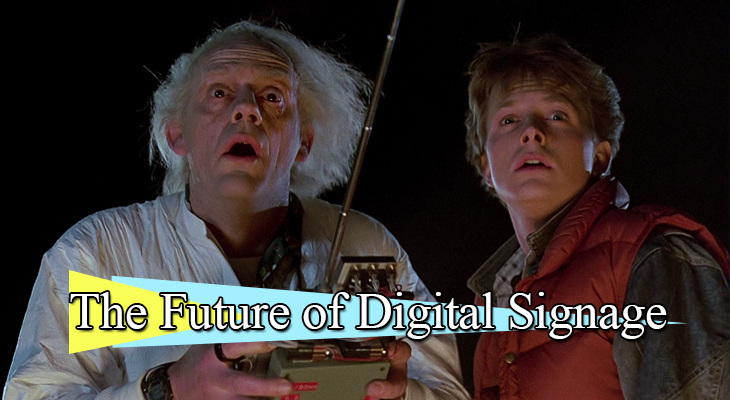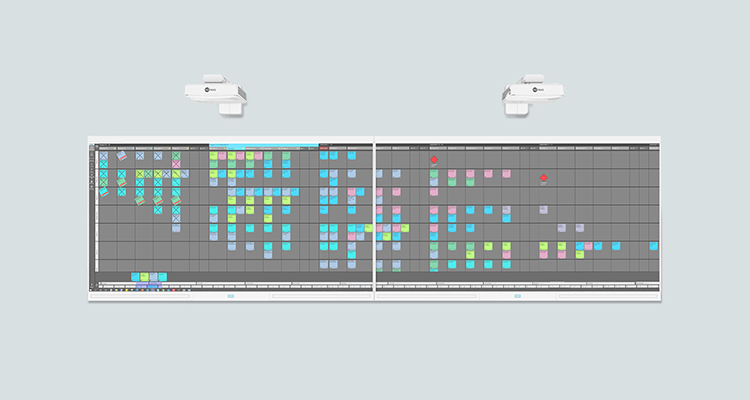Digital Signage – Three Predictions for the Future

Digital Signage and the Future…
It’s the turn of the year and once again I feel old. But at least I don’t age like digital signage technology. If the dog/human age ratio is around 7:1, then digital signage must be around 47:1. Amiright?
During my recent reflection while setting travel plans for DSE 2016, I realize that I’ve been working with digital signage for over 10 years…so in a sense, I feel 147 years old. My underarms may sag to the floor, but hey, I’m still a spring chicken.
We can’t help but look at where we’ve come and attempt to extrapolate where we’ll go in the coming years. To me, we’re still in the middle of a digital signage software revolution.
To guide this extrapolation (I love that word), here are three technological principles that I will use to my own advantage to hopefully shed some light on the future. Today, I’m ONLY going to talk about the future of SaaS digital signage. This is all my opinion by the way, and I’m eager to hear any other points of view. Like Gerber’s E-Myth…the world is open to interpretation.
Principle 1: Software-Stumps Spread Their Branches Through Integration
As digital signage attracts more of a mass audience, the needs of the customer gradually become more clear. This natural progression occurs because customers need time to know how to apply the technology to their lives. For example, software needs for features like scheduling, user management, distribution grouping and info feeds seem to be a standard necessity for digital signage customers nowadays.
Once those basic needs are fulfilled, SaaS tends spread it’s branches and integrate with other complementary platforms. Protocols and connector-apps develop to help information flow from one database to another. Why? The answer is two-fold: Associative on boarding…which means users of one platform will gain exposure to the other. As well as the obvious answer — to deliver more value and one-up competitors. Though they are not primarily used for digital signage, an example of connector apps would be something like: IFTTT or Zapier.
Principle 2: Decentralization of Bottlenecks
Decentralization tends to occur as the gears in the whole system become heavier. It takes full companies to turn these gears eventually. Decentralization means that market opportunities develop due to the formation of bottlenecks; things like nationwide installation, content creation / feeds and IT support will become digital signage industries of their own.
It’s already common place for a customer to obtain their digital signage SaaS from one company, have it installed by another, have the content fed in from a creative agency, and have it all monitored and supported by yet another firm. Who ya gonna call? Ghostbusters. I’m not sure why.
My prediction is that this trend will continue and digital signage companies in all areas will become more invested in other firms to handle their personal bottlenecks.
Principle 3: The Niche Revolution
Let’s face it, we’re all screaming babies when it comes to our apps, emails, CRMs and the like. We want the apps to speak to us like a mirror on the wall, telling us we’re beautiful and they know just the answer for all of our shortcomings.
The snowy-niche-driven-digital-signage-storm (I went cross-eyed just typing that) will begin to develop… and hanging icicles pierce cross-sections of the market with ever-growing product depth. Whole products of digital signage are placed on digital shelves to serve the long tail of specific customer needs.
White labeled SAAS will become standardized for integrators with a special hold on these cross-sections of customers. They’ll be able to customize the structure of their SAAS software to match the needs of the end-user perfectly. Some major problems will be solved. For example, we know the digital signage pricing game is insanely dis proportioned. There’s no right way to set a price that makes everyone happy. Enter the white-labelers to tailor their product offerings, content offerings and hardware offerings through online marketplaces with special access granted only to those that fit the niche.
A classic example and proof of this concept — check out Rise Vision’s big discussion about white labeling.If you’re for it, go ahead and create a free online account and give them your opinion. They respond to almost every post:
To sum up…These aren’t very specific predictions… but again — Michael Gerber or a palm reader will remind you — the world is open to interpretation. Especially in digital signage… Those who realize this fact have the most control over the elements in the inevitable painting. And somehow… Al Gore takes credit for all of it.
See you at DSE, planet Earth.





